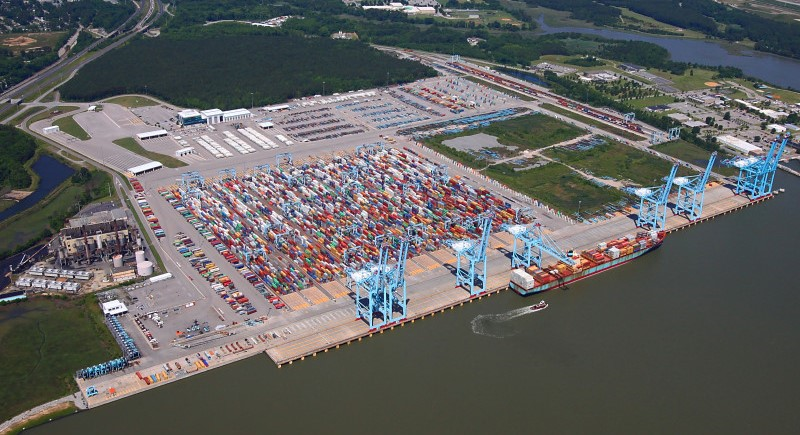Port Strike Poses Risk to Supply Chain Stability
Union dockworkers at 36 U.S. East Coast and Gulf Coast ports from Maine to Texas went on strike Tuesday, Oct. 1 for the first time since 1977.
 |
| Labor negotiations have stalled between the International Longshoremen's Association union and the U.S. Maritime Alliance leading to the first strike since 1977. Photo provided by USMX |
The labor contract between the International Longshoremen's Association union, which represents the 45,000 port workers and the U.S. Maritime Alliance (USMX) employer group expired Monday at midnight.
Negotiations on a new six-year contract stalled over demands for pay increases and a ban on automation of certain job functions. The dockworkers are seeking significantly higher wages and a ban of any automation of cranes, gates and container moving trucks that are used in the loading or unloading of freight at the ports.
If the strike drags on, prices for various goods could increase and there could be shortages of some items.
Analysts have reported that perishable goods and fresh produce, specifically bananas, will likely be first impacted. However, should the strike drag on, it could lead to a significant impact on the supply chain for various goods.
Under the 1947 Taft-Hartley Act, if the strike were deemed a danger to U.S. economic health, President Joe Biden could seek a court order for an 80-day cooling-off period that would suspend the strike.
However, the White House has repeatedly indicated no intention of using federal powers to end the contract dispute.
The Associated Builders and Contractors is urging President Biden to invoke his powers.
“If the Biden-Harris administration is serious about rebuilding America, and maximizing hundreds of billions of dollars in taxpayer investments in infrastructure, clean energy and manufacturing, the construction industry simply cannot afford any more supply chain disruptions and additional cost hikes on critical materials,” said Kristen Swearingen, ABC vice president of legislative & political affairs.
She noted that the price of construction materials has already increased by 40% since February 2020 and there have been reports of widespread shortages of key construction materials.
“Coupled with the construction industry’s skilled labor shortage topping half a million in 2024, these industry headwinds needlessly inflate the cost of federal and federally assisted construction projects and are exacerbated by this administration’s weak leadership and anti-competitive executive actions,” Swearingen said.
 |
| ILA president Harold Daggett was on the picket lines at the start of the strike. |
The union’s opening offer in the talks was for a 77% pay raise over the six-year life of the contract, with ILA president Harold Daggett saying it’s necessary to make up for inflation and years of small raises. ILA members make a base salary of about $81,000 per year, but some can pull in over $200,000 annually with substantial amounts of overtime.
On Monday evening, the USMX had increased its offer to 50% raises over six years and pledged to keep limits on automation in place from the old contract.
According to an alliance statement, the offer exceeded every other recent union settlement, while addressing inflation and recognizing the ILA’s hard work to keep the economy running.
By early Tuesday, the ILA issued a statement rejecting the offer because it did not address the demands of the dockworkers adequately.
Daggett said the union is pushing for more, including a $5 per hour raise for each year of the new six-year contract.
“We are now demanding $5 an hour increase in wages for each of the six years of a new Dagget said their position is firm in believing in the value the rank-and-file members bring to the industry.
“They deserve a contract that recognizes their contributions, secures their jobs, and reflects the profits generated by their labor,” he said, adding that the ILA is steadfastly against any form of automation full or semi that replaces jobs or historical work functions.
“We will not accept the loss of work and livelihood for our members due to automation,” Dagget said. “Our position is clear; the preservation of jobs and historical work functions is non-negotiable.”
Experts say it’s not clear whether automation would lead to layoffs, but the union has remained firm in its position.
According to the ILA president, they have been prepared to negotiate with the USMX for nearly two years. Prior to the recent offer, the last offer from the USMX came in February 2023.
Analysts said the two sides have not had formal negotiations since June. It remains unclear how far apart they are.
Acting Secretary of Labor Julie Su said Tuesday that she has spent the last week and more on the phone and in meetings with the parties urging them to find a way to a fair contract.
She said the USMX has "refused to put an offer on the table that reflects workers’ sacrifice and contributions to their employers' profits."
"The parties need to get back to the negotiating table, and that must begin with these giant shipping magnates acknowledging that if they can make record profits, their workers should share in that economic success," she said.
Shippers have made record profits since the pandemic, and, in some cases, have seen profits grow more than 800%, according to a statement from the White House.
"It's only fair that workers who put themselves at risk during the pandemic to keep ports open see a meaningful increase in their wages, as well,” the Biden administration statement said.
The ILA plans for the demonstrations to continue around the clock, 24/7, until USMX meets its demands.
















